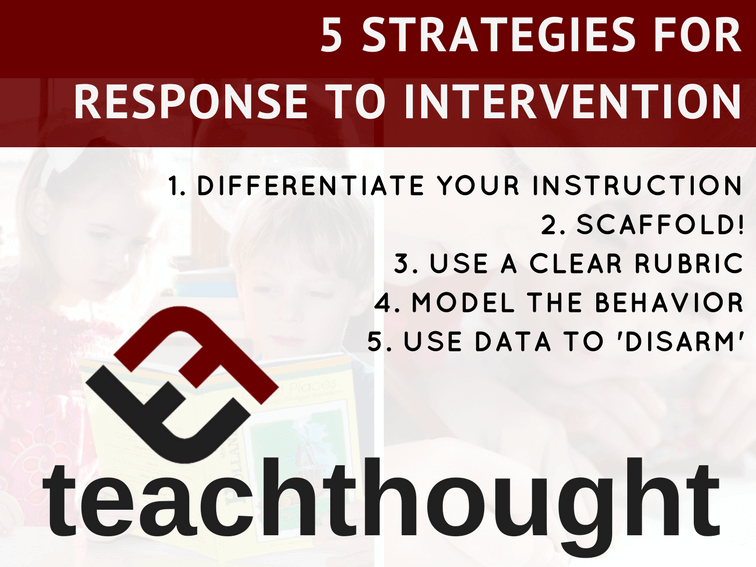
What Are The Best Strategies For Response To Intervention?
contributed by Dan Henderson
Help!
After many failed attempts to try to influence a child, the teacher or parent needs to start using an intervention. When we here the word intervention we may think we need to invite the whole family over to sit down around the couch to talk to Jimmy.
Most interventions do not warrant a family reality show. An intervention should be used to change a current situation or create a replacement behavior. In academia we rate the interventions on a scale of one to three, three being the more intense interventions. When I teach I use a range of interventions all the time. I break up these interventions into broad categories of academic and social/emotional.
The purpose of any intervention is to help learners access the curriculum with the best chance for success.
Three Academic Interventions Any Teacher Can Use
1. Differentiate your instruction
I took a course on how students learned by using objects to start the conversation instead of starting with a written text.
The children had to touch and guess what the object was used for in the past. It was a tapered 18th-century candle mold. Then we watched a video on the 18th-century candle-making process. Only after this time did we read a primary source written article. There are many ways to differentiate and this was one example. The key is to always differentiate your lesson.
2. Scaffold!
It sounds rudimentary, but when you name the steps you scaffolded the problem so that you can fix any step the student misses. It is easier to fix one step at a time than a whole staircase.
3. Use a clear rubric
Show students an example of below and grade-level expectations before you release them to do independent work. They will be able to have a reference to guide their work when you give students examples with a rubric to follow.
Two Social/Emotional Interventions Any Teacher Can Use
1. Model the behavior
Many children or teenagers do not know how to act simply because they have not seen or experienced the behavior to reproduce that particular demeanor. Some quick ways to model behavior are to watch a video and create class rules that the teacher or students model. Afterward, the class agrees to follow what they help create. The real problem with expecting a certain type of behavior is not giving the child a chance to witness the behavior they need to mimic.
2. Use data to ‘disarm’
Children are master manipulators. They will wear you down with whining. If you do not have a protocol for how you handle the interpersonal conflicts between child and teacher it is easier to not back down. The rules have been discussed and it is natural that the progression of consequences will follow down a set path. There is little room for debate when the rules have already been agreed to.
To see if an intervention is working you need a baseline score, measurable goal, determine the frequency of the intervention (ex: 30 mins four times a week), identify who is tracking or administering the intervention (is the intervention tracked by the teacher or student) and to verify it is a scientifically proven intervention. If you do not have these basics it is hard to measure the results of any intervention.
A story from a class down the hall…
“When you interrupt your classmates again and again they start to call you a jerk!” Mr. Connell said to Eric as he blurted out the answer again. Mr. Connell referred to this behavior as stealing the knowledge from the class. Although it was not constructive to call Eric a jerk, Mr. Connell had run out of patience. He came to the RTI (Response to Intervention) team for advice.
“Eric just won’t stop calling out the answer. I keep telling him to stop and then I have put him out of the class circle when he blurts out the answer. ” Mr. Connell is explaining his strategy that really is not an intervention.
“Have you tried any other strategies?” The team asks patiently.
“Well, then I take away a class privilege.” Mr. Connell leans back in his chair and rubs his hands over his head.
“Does he seem to care?” The team asks.
“No, not really. That is why I came to you.”
I spoke up. “I think you should try a few strategies. First, you should find out what he wants and have a system that he can track for when he does not call out. Second, I think you need a visual sign to show Eric when he can and can not ask questions. I think you need to reward him on a goal he wants.”
“That’s it?” Mr. Connell asks shrugging his hands indifferently. “Alright, I will try it next week.” We give Mr. Connell some data collection sheets Eric can use to track his progress. Four weeks go by and he brings the sheets back to the team. With bright blue ink some words are written, I am not a jerk.
“Why would Eric think he is a jerk?” I ask.
“Never mind–the important thing is that he is not a jerk.” Mr. Connell grins unabashedly.
Teachers and parents can feel overwhelmed by certain behaviors children are producing. When you feel stuck get an outside perspective. The important part is being able to find a replacement behavior and track to see if the intervention is working. If not, that means that the student lacks the kind of access to curriculum that gives them the best opportunity for success.
And that’s not an option.
Note: A good book to review replacement behaviors is the Hawthorne Behavior Intervention Manuel.
Note 2: If you enjoyed this story check out Dan’s new book That’s Special A Survival Guide To Teaching
5 Strategies For Response To Intervention
